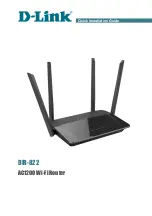
Chapter 5
Routed PPPoE
E-DOC-CTC-20051017-0167 v1.0
38
Routed PPPoE – TCP/IP
Configuration
Three popular TCP/IP scenarios exist for Routed PPPoE implementations:
The Routed PPPoE interface negotiates a local PPP peer IP address with the
remote PPP peer of the Broadband Remote Access Server (BRAS) (actually the
remote PPP peer will provide the local PPP peer IP address to use). By
enabling NAPT on the Routed PPPoE interface, IP Routing makes
communication possible between the interface and the nodes on the Local
Network. Whether the IP configuration of the local nodes is done manually or
via the DHCP server of the SpeedTouch™ is irrelevant for end-to-end
connectivity.
The Service Provider assigns an IP address to the Routed PPPoE connection.
When the Routed PPPoE session is started, the SpeedTouch™ will put this IP
address in an existing local DHCP pool. The next time a local node renews its
IP address, the SpeedTouch™ assigns the public IP address to the local node.
The SpeedTouch™ itself stays in unnumbered mode.
This scenario is referred to as DHCP spoofing.
The Service Provider assigns a subnet to the Routed PPPoE connection. When
this Routed PPPoE session is started, the SpeedTouch™ will populate an
existing local DHCP pool with this subnet. The next time a local node renews
its IP address, it receives an IP address from the PPP IPCP subnet masking
DHCP pool.
This scenario is often referred to as IPCP subnet masking.
Protocol stack
The figure below shows the routed PPPoE protocol stack.
Connection modes
Three modes exist to start a Routed PPPoE session:
Dial-in: The session is opened manually.
Always-On: After the SpeedTouch™ is powered, it automatically tries to start
the session.
Dial-on-Demand: The session is started automatically, triggered by packets
arriving from the local network, destined for a Routed PPPoE connection.
ip
mac
eth
adsl
CPE
DSLAM
PC
Service
Gateway
RFC1483b
AAL5/ATM
PHY
IP
PPP
ppp
ppp
mac
PPPoE
PPPoE
The Dial-In connection mode is the only connection mode that requires an
intervention from the user. The user can open Routed PPPoE Dial-In
connections via the SpeedTouch™ Web interface.
Summary of Contents for SpeedTouch
Page 2: ......
Page 3: ...SpeedTouch Internet Connection Configuration Guide R5 4 and higher...
Page 8: ...Contents E DOC CTC 20051017 0167 v1 0 iv...
Page 10: ...E DOC CTC 20051017 0167 v1 0 2...
Page 18: ...Chapter 1 Introduction E DOC CTC 20051017 0167 v1 0 10...
Page 32: ...Chapter 3 Routed Ethernet E DOC CTC 20051017 0167 v1 0 24...
Page 56: ...Chapter 5 Routed PPPoE E DOC CTC 20051017 0167 v1 0 48...
Page 66: ...Chapter 6 PPPoE Relay E DOC CTC 20051017 0167 v1 0 58...
Page 108: ...Chapter 10 Routed PPPoI E DOC CTC 20051017 0167 v1 0 100...
Page 109: ......
















































